Leadership Essay: Ethical Failures and the Enron Case Study Analysis
VerifiedAdded on 2021/06/18
|6
|1363
|17
Essay
AI Summary
This essay analyzes leadership ethics using the Enron case study, focusing on the company's collapse due to unethical practices and poor leadership. It explores the responsibilities of leaders, particularly Jeffrey Skilling and Kenneth Lay, in fostering a culture that prioritized short-term gains over ethical conduct and long-term sustainability. The essay highlights the importance of servant leadership, clear communication, and ethical standards in preventing such failures. It also suggests improvements in organizational structures, motivational processes, and reward systems to ensure employee well-being and organizational success. The paper emphasizes the critical role of leaders in establishing effective communication channels and organizational structures aligned with the company's goals. The conclusion reiterates the importance of ethical leadership in driving business success and preventing conflicts of interest, as demonstrated by the Enron case.
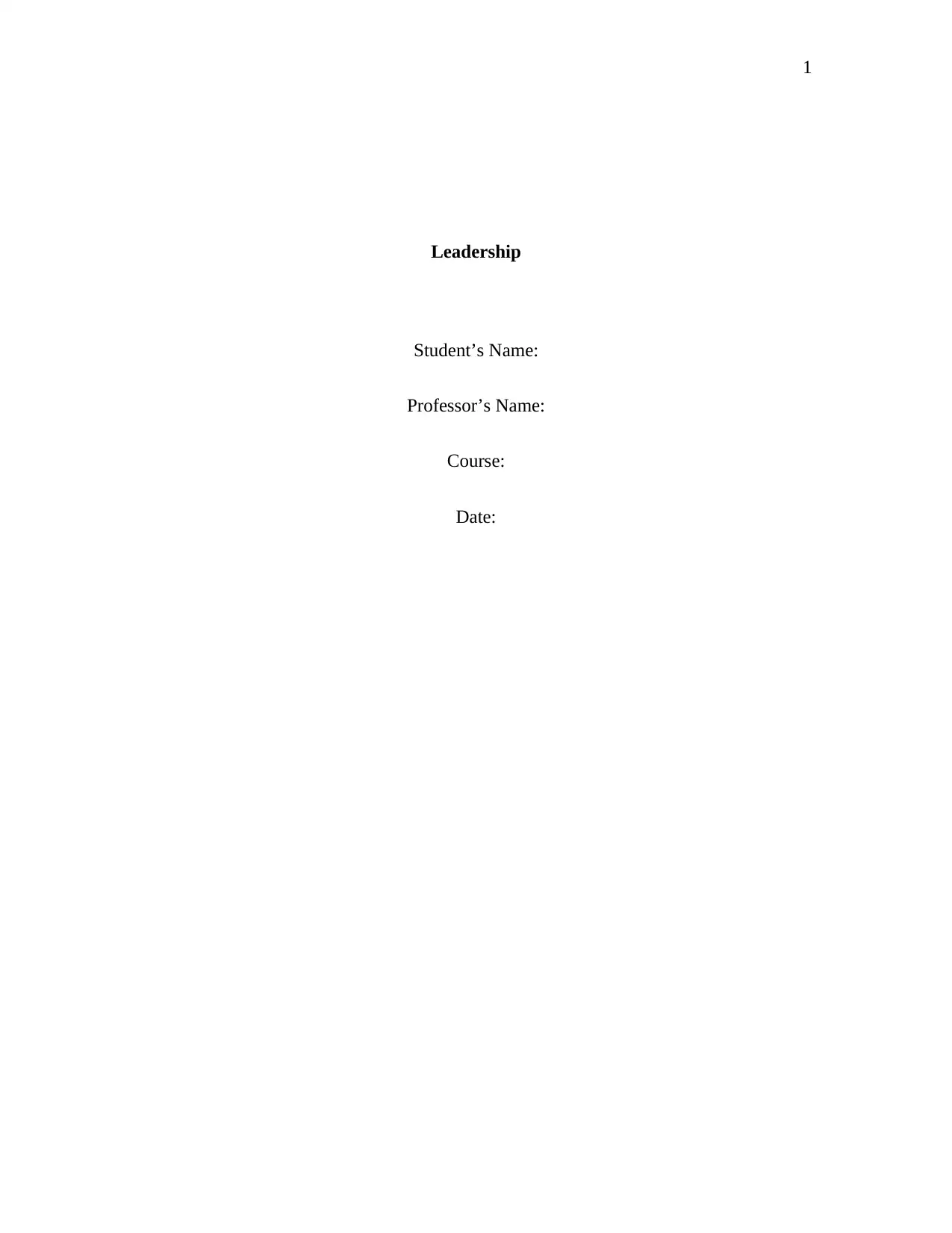
Leadership
Student’s Name:
Professor’s Name:
Course:
Date:
1
Student’s Name:
Professor’s Name:
Course:
Date:
1
Paraphrase This Document
Need a fresh take? Get an instant paraphrase of this document with our AI Paraphraser
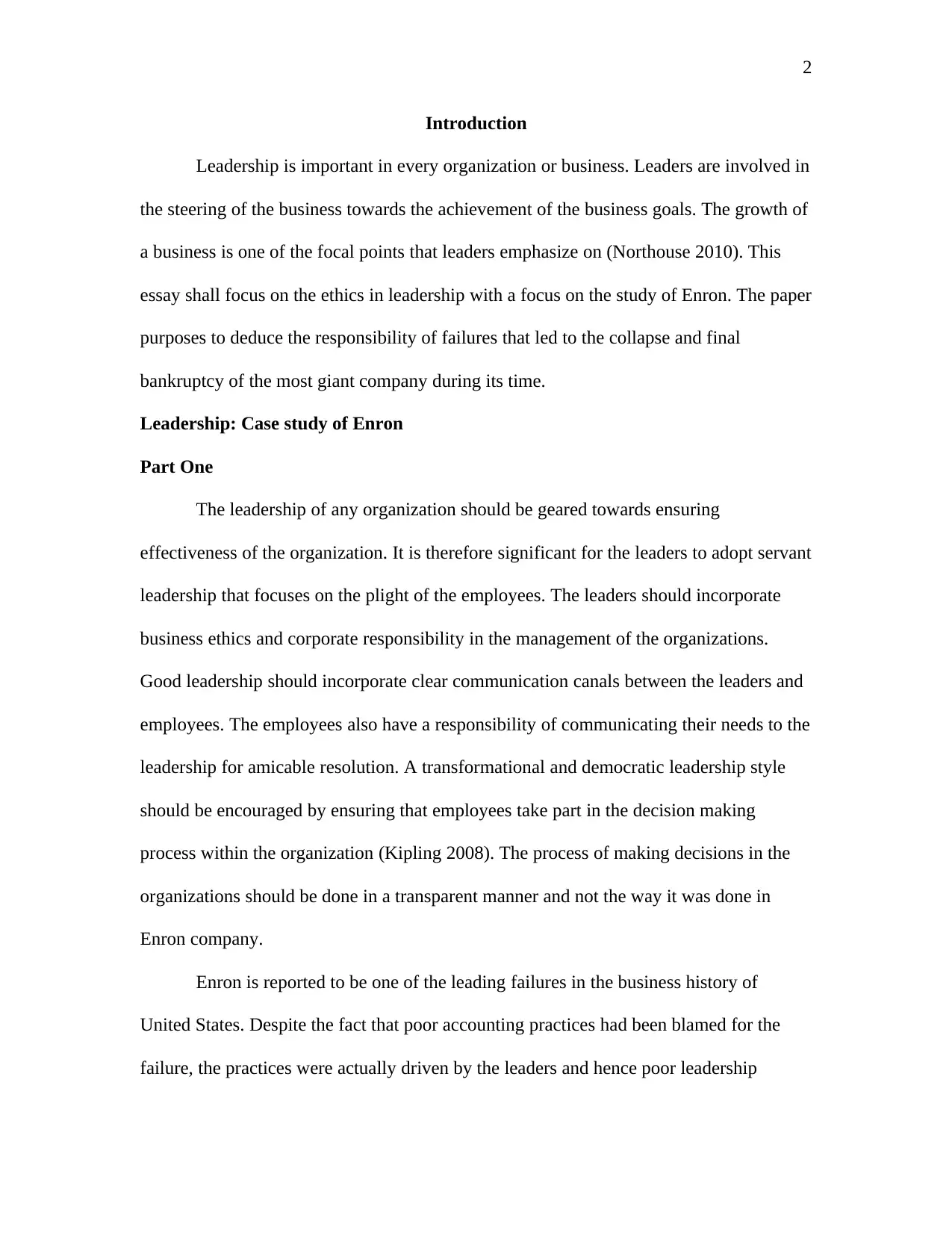
Introduction
Leadership is important in every organization or business. Leaders are involved in
the steering of the business towards the achievement of the business goals. The growth of
a business is one of the focal points that leaders emphasize on (Northouse 2010). This
essay shall focus on the ethics in leadership with a focus on the study of Enron. The paper
purposes to deduce the responsibility of failures that led to the collapse and final
bankruptcy of the most giant company during its time.
Leadership: Case study of Enron
Part One
The leadership of any organization should be geared towards ensuring
effectiveness of the organization. It is therefore significant for the leaders to adopt servant
leadership that focuses on the plight of the employees. The leaders should incorporate
business ethics and corporate responsibility in the management of the organizations.
Good leadership should incorporate clear communication canals between the leaders and
employees. The employees also have a responsibility of communicating their needs to the
leadership for amicable resolution. A transformational and democratic leadership style
should be encouraged by ensuring that employees take part in the decision making
process within the organization (Kipling 2008). The process of making decisions in the
organizations should be done in a transparent manner and not the way it was done in
Enron company.
Enron is reported to be one of the leading failures in the business history of
United States. Despite the fact that poor accounting practices had been blamed for the
failure, the practices were actually driven by the leaders and hence poor leadership
2
Leadership is important in every organization or business. Leaders are involved in
the steering of the business towards the achievement of the business goals. The growth of
a business is one of the focal points that leaders emphasize on (Northouse 2010). This
essay shall focus on the ethics in leadership with a focus on the study of Enron. The paper
purposes to deduce the responsibility of failures that led to the collapse and final
bankruptcy of the most giant company during its time.
Leadership: Case study of Enron
Part One
The leadership of any organization should be geared towards ensuring
effectiveness of the organization. It is therefore significant for the leaders to adopt servant
leadership that focuses on the plight of the employees. The leaders should incorporate
business ethics and corporate responsibility in the management of the organizations.
Good leadership should incorporate clear communication canals between the leaders and
employees. The employees also have a responsibility of communicating their needs to the
leadership for amicable resolution. A transformational and democratic leadership style
should be encouraged by ensuring that employees take part in the decision making
process within the organization (Kipling 2008). The process of making decisions in the
organizations should be done in a transparent manner and not the way it was done in
Enron company.
Enron is reported to be one of the leading failures in the business history of
United States. Despite the fact that poor accounting practices had been blamed for the
failure, the practices were actually driven by the leaders and hence poor leadership
2
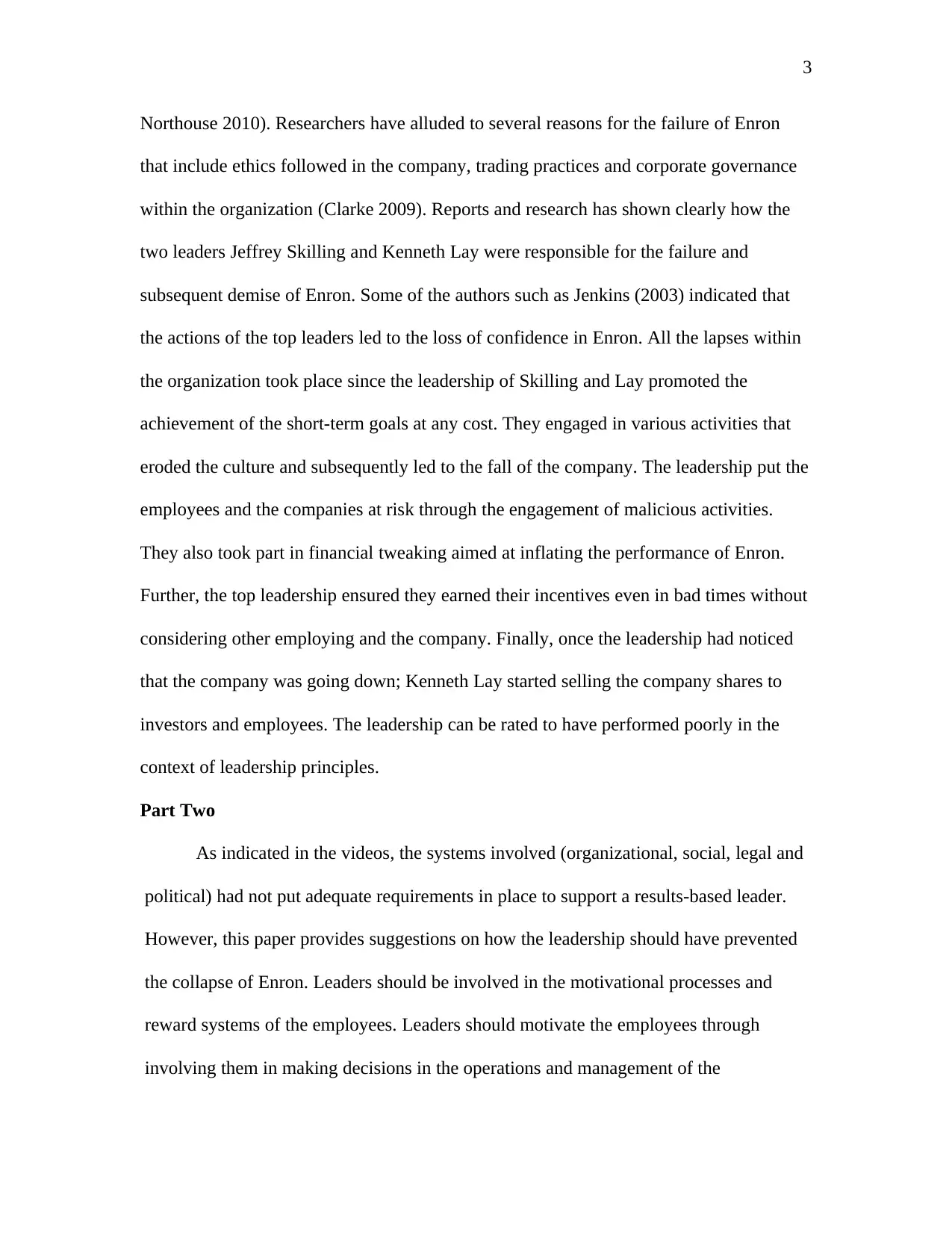
Northouse 2010). Researchers have alluded to several reasons for the failure of Enron
that include ethics followed in the company, trading practices and corporate governance
within the organization (Clarke 2009). Reports and research has shown clearly how the
two leaders Jeffrey Skilling and Kenneth Lay were responsible for the failure and
subsequent demise of Enron. Some of the authors such as Jenkins (2003) indicated that
the actions of the top leaders led to the loss of confidence in Enron. All the lapses within
the organization took place since the leadership of Skilling and Lay promoted the
achievement of the short-term goals at any cost. They engaged in various activities that
eroded the culture and subsequently led to the fall of the company. The leadership put the
employees and the companies at risk through the engagement of malicious activities.
They also took part in financial tweaking aimed at inflating the performance of Enron.
Further, the top leadership ensured they earned their incentives even in bad times without
considering other employing and the company. Finally, once the leadership had noticed
that the company was going down; Kenneth Lay started selling the company shares to
investors and employees. The leadership can be rated to have performed poorly in the
context of leadership principles.
Part Two
As indicated in the videos, the systems involved (organizational, social, legal and
political) had not put adequate requirements in place to support a results-based leader.
However, this paper provides suggestions on how the leadership should have prevented
the collapse of Enron. Leaders should be involved in the motivational processes and
reward systems of the employees. Leaders should motivate the employees through
involving them in making decisions in the operations and management of the
3
that include ethics followed in the company, trading practices and corporate governance
within the organization (Clarke 2009). Reports and research has shown clearly how the
two leaders Jeffrey Skilling and Kenneth Lay were responsible for the failure and
subsequent demise of Enron. Some of the authors such as Jenkins (2003) indicated that
the actions of the top leaders led to the loss of confidence in Enron. All the lapses within
the organization took place since the leadership of Skilling and Lay promoted the
achievement of the short-term goals at any cost. They engaged in various activities that
eroded the culture and subsequently led to the fall of the company. The leadership put the
employees and the companies at risk through the engagement of malicious activities.
They also took part in financial tweaking aimed at inflating the performance of Enron.
Further, the top leadership ensured they earned their incentives even in bad times without
considering other employing and the company. Finally, once the leadership had noticed
that the company was going down; Kenneth Lay started selling the company shares to
investors and employees. The leadership can be rated to have performed poorly in the
context of leadership principles.
Part Two
As indicated in the videos, the systems involved (organizational, social, legal and
political) had not put adequate requirements in place to support a results-based leader.
However, this paper provides suggestions on how the leadership should have prevented
the collapse of Enron. Leaders should be involved in the motivational processes and
reward systems of the employees. Leaders should motivate the employees through
involving them in making decisions in the operations and management of the
3
⊘ This is a preview!⊘
Do you want full access?
Subscribe today to unlock all pages.

Trusted by 1+ million students worldwide
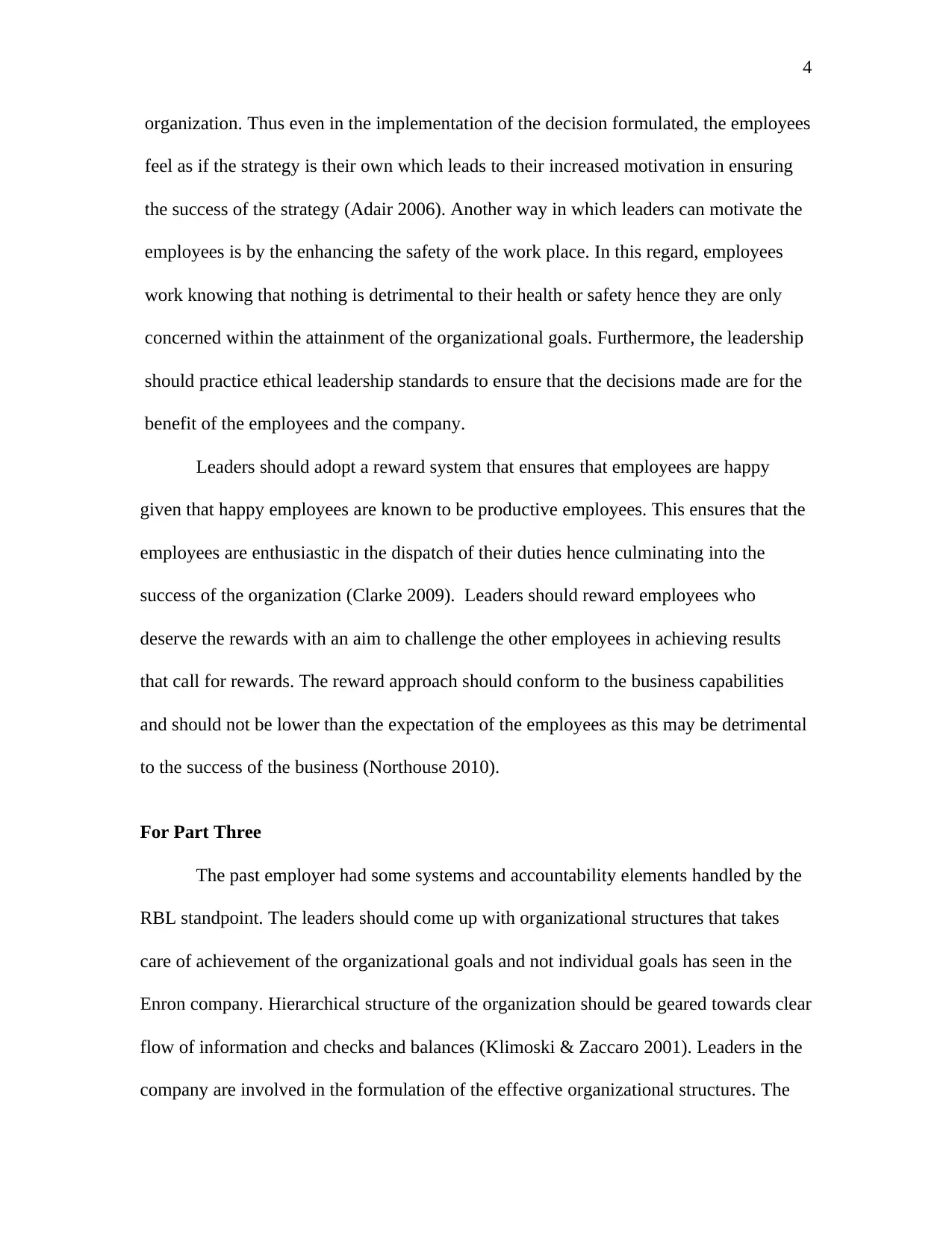
organization. Thus even in the implementation of the decision formulated, the employees
feel as if the strategy is their own which leads to their increased motivation in ensuring
the success of the strategy (Adair 2006). Another way in which leaders can motivate the
employees is by the enhancing the safety of the work place. In this regard, employees
work knowing that nothing is detrimental to their health or safety hence they are only
concerned within the attainment of the organizational goals. Furthermore, the leadership
should practice ethical leadership standards to ensure that the decisions made are for the
benefit of the employees and the company.
Leaders should adopt a reward system that ensures that employees are happy
given that happy employees are known to be productive employees. This ensures that the
employees are enthusiastic in the dispatch of their duties hence culminating into the
success of the organization (Clarke 2009). Leaders should reward employees who
deserve the rewards with an aim to challenge the other employees in achieving results
that call for rewards. The reward approach should conform to the business capabilities
and should not be lower than the expectation of the employees as this may be detrimental
to the success of the business (Northouse 2010).
For Part Three
The past employer had some systems and accountability elements handled by the
RBL standpoint. The leaders should come up with organizational structures that takes
care of achievement of the organizational goals and not individual goals has seen in the
Enron company. Hierarchical structure of the organization should be geared towards clear
flow of information and checks and balances (Klimoski & Zaccaro 2001). Leaders in the
company are involved in the formulation of the effective organizational structures. The
4
feel as if the strategy is their own which leads to their increased motivation in ensuring
the success of the strategy (Adair 2006). Another way in which leaders can motivate the
employees is by the enhancing the safety of the work place. In this regard, employees
work knowing that nothing is detrimental to their health or safety hence they are only
concerned within the attainment of the organizational goals. Furthermore, the leadership
should practice ethical leadership standards to ensure that the decisions made are for the
benefit of the employees and the company.
Leaders should adopt a reward system that ensures that employees are happy
given that happy employees are known to be productive employees. This ensures that the
employees are enthusiastic in the dispatch of their duties hence culminating into the
success of the organization (Clarke 2009). Leaders should reward employees who
deserve the rewards with an aim to challenge the other employees in achieving results
that call for rewards. The reward approach should conform to the business capabilities
and should not be lower than the expectation of the employees as this may be detrimental
to the success of the business (Northouse 2010).
For Part Three
The past employer had some systems and accountability elements handled by the
RBL standpoint. The leaders should come up with organizational structures that takes
care of achievement of the organizational goals and not individual goals has seen in the
Enron company. Hierarchical structure of the organization should be geared towards clear
flow of information and checks and balances (Klimoski & Zaccaro 2001). Leaders in the
company are involved in the formulation of the effective organizational structures. The
4
Paraphrase This Document
Need a fresh take? Get an instant paraphrase of this document with our AI Paraphraser
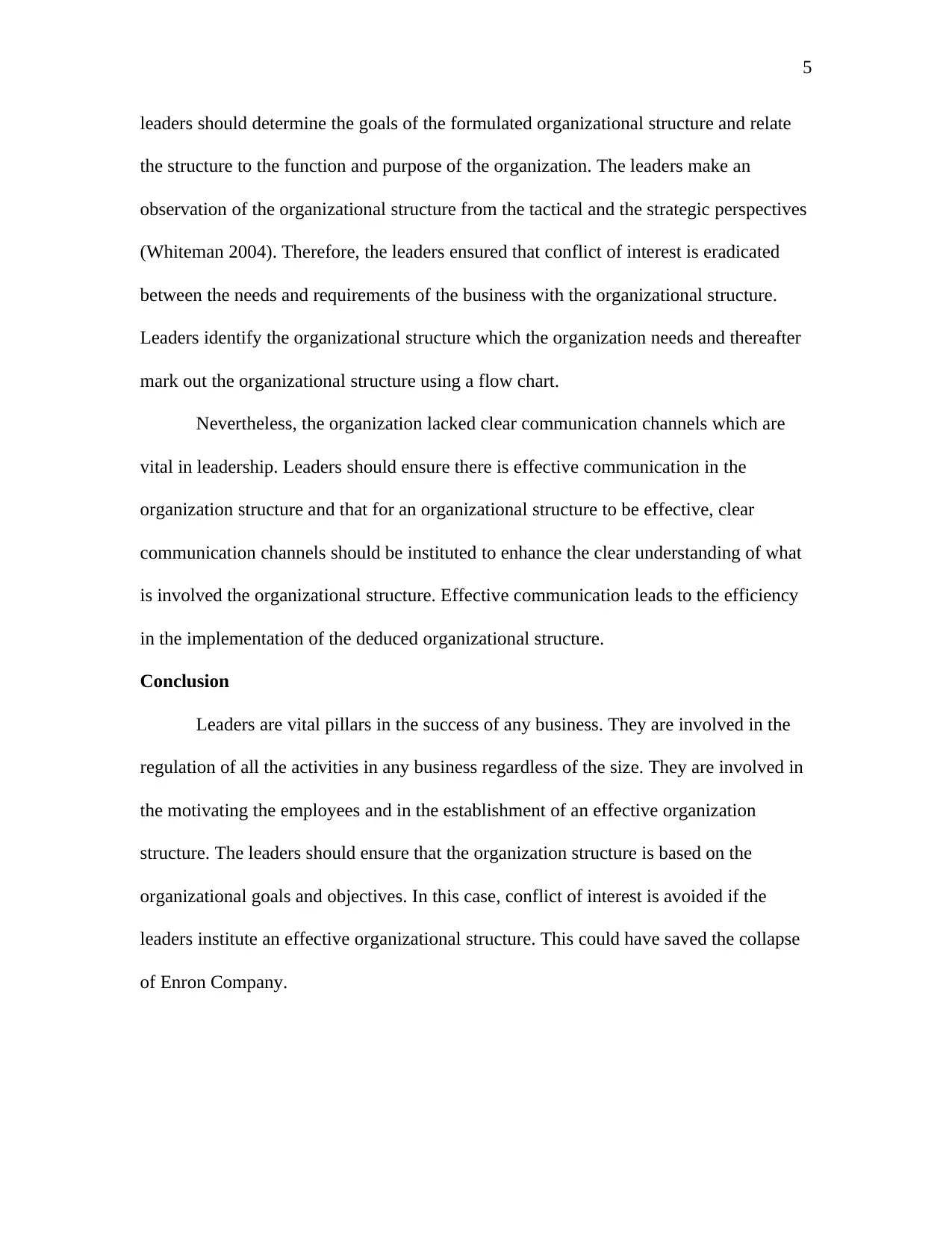
leaders should determine the goals of the formulated organizational structure and relate
the structure to the function and purpose of the organization. The leaders make an
observation of the organizational structure from the tactical and the strategic perspectives
(Whiteman 2004). Therefore, the leaders ensured that conflict of interest is eradicated
between the needs and requirements of the business with the organizational structure.
Leaders identify the organizational structure which the organization needs and thereafter
mark out the organizational structure using a flow chart.
Nevertheless, the organization lacked clear communication channels which are
vital in leadership. Leaders should ensure there is effective communication in the
organization structure and that for an organizational structure to be effective, clear
communication channels should be instituted to enhance the clear understanding of what
is involved the organizational structure. Effective communication leads to the efficiency
in the implementation of the deduced organizational structure.
Conclusion
Leaders are vital pillars in the success of any business. They are involved in the
regulation of all the activities in any business regardless of the size. They are involved in
the motivating the employees and in the establishment of an effective organization
structure. The leaders should ensure that the organization structure is based on the
organizational goals and objectives. In this case, conflict of interest is avoided if the
leaders institute an effective organizational structure. This could have saved the collapse
of Enron Company.
5
the structure to the function and purpose of the organization. The leaders make an
observation of the organizational structure from the tactical and the strategic perspectives
(Whiteman 2004). Therefore, the leaders ensured that conflict of interest is eradicated
between the needs and requirements of the business with the organizational structure.
Leaders identify the organizational structure which the organization needs and thereafter
mark out the organizational structure using a flow chart.
Nevertheless, the organization lacked clear communication channels which are
vital in leadership. Leaders should ensure there is effective communication in the
organization structure and that for an organizational structure to be effective, clear
communication channels should be instituted to enhance the clear understanding of what
is involved the organizational structure. Effective communication leads to the efficiency
in the implementation of the deduced organizational structure.
Conclusion
Leaders are vital pillars in the success of any business. They are involved in the
regulation of all the activities in any business regardless of the size. They are involved in
the motivating the employees and in the establishment of an effective organization
structure. The leaders should ensure that the organization structure is based on the
organizational goals and objectives. In this case, conflict of interest is avoided if the
leaders institute an effective organizational structure. This could have saved the collapse
of Enron Company.
5
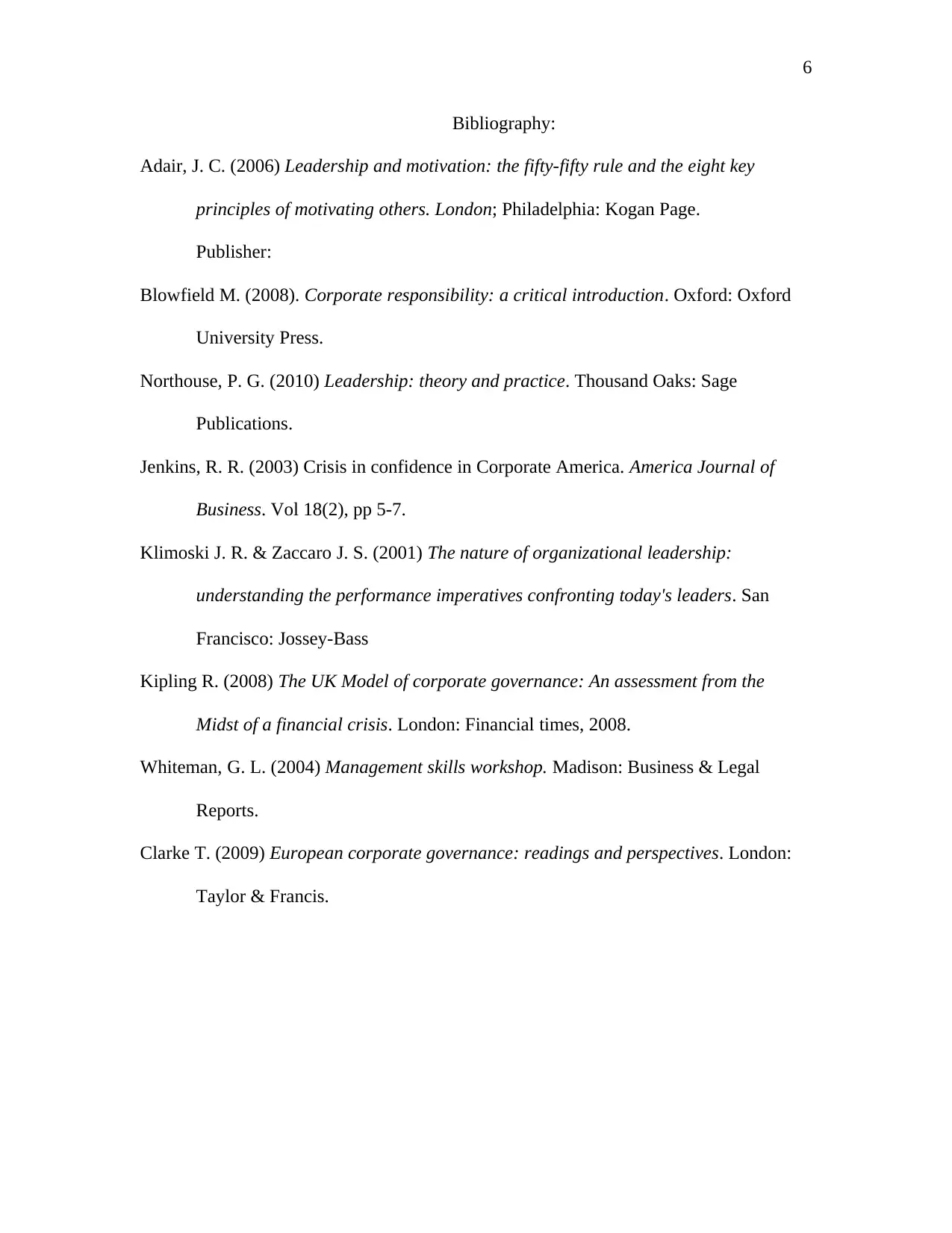
Bibliography:
Adair, J. C. (2006) Leadership and motivation: the fifty-fifty rule and the eight key
principles of motivating others. London; Philadelphia: Kogan Page.
Publisher:
Blowfield M. (2008). Corporate responsibility: a critical introduction. Oxford: Oxford
University Press.
Northouse, P. G. (2010) Leadership: theory and practice. Thousand Oaks: Sage
Publications.
Jenkins, R. R. (2003) Crisis in confidence in Corporate America. America Journal of
Business. Vol 18(2), pp 5-7.
Klimoski J. R. & Zaccaro J. S. (2001) The nature of organizational leadership:
understanding the performance imperatives confronting today's leaders. San
Francisco: Jossey-Bass
Kipling R. (2008) The UK Model of corporate governance: An assessment from the
Midst of a financial crisis. London: Financial times, 2008.
Whiteman, G. L. (2004) Management skills workshop. Madison: Business & Legal
Reports.
Clarke T. (2009) European corporate governance: readings and perspectives. London:
Taylor & Francis.
6
Adair, J. C. (2006) Leadership and motivation: the fifty-fifty rule and the eight key
principles of motivating others. London; Philadelphia: Kogan Page.
Publisher:
Blowfield M. (2008). Corporate responsibility: a critical introduction. Oxford: Oxford
University Press.
Northouse, P. G. (2010) Leadership: theory and practice. Thousand Oaks: Sage
Publications.
Jenkins, R. R. (2003) Crisis in confidence in Corporate America. America Journal of
Business. Vol 18(2), pp 5-7.
Klimoski J. R. & Zaccaro J. S. (2001) The nature of organizational leadership:
understanding the performance imperatives confronting today's leaders. San
Francisco: Jossey-Bass
Kipling R. (2008) The UK Model of corporate governance: An assessment from the
Midst of a financial crisis. London: Financial times, 2008.
Whiteman, G. L. (2004) Management skills workshop. Madison: Business & Legal
Reports.
Clarke T. (2009) European corporate governance: readings and perspectives. London:
Taylor & Francis.
6
⊘ This is a preview!⊘
Do you want full access?
Subscribe today to unlock all pages.

Trusted by 1+ million students worldwide
1 out of 6
Related Documents
Your All-in-One AI-Powered Toolkit for Academic Success.
+13062052269
info@desklib.com
Available 24*7 on WhatsApp / Email
![[object Object]](/_next/static/media/star-bottom.7253800d.svg)
Unlock your academic potential
Copyright © 2020–2025 A2Z Services. All Rights Reserved. Developed and managed by ZUCOL.




